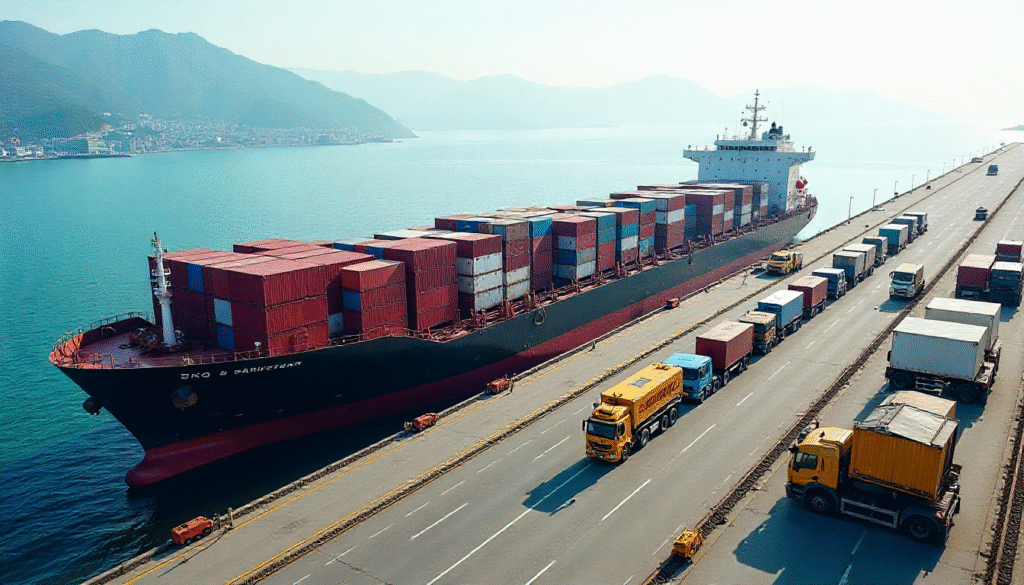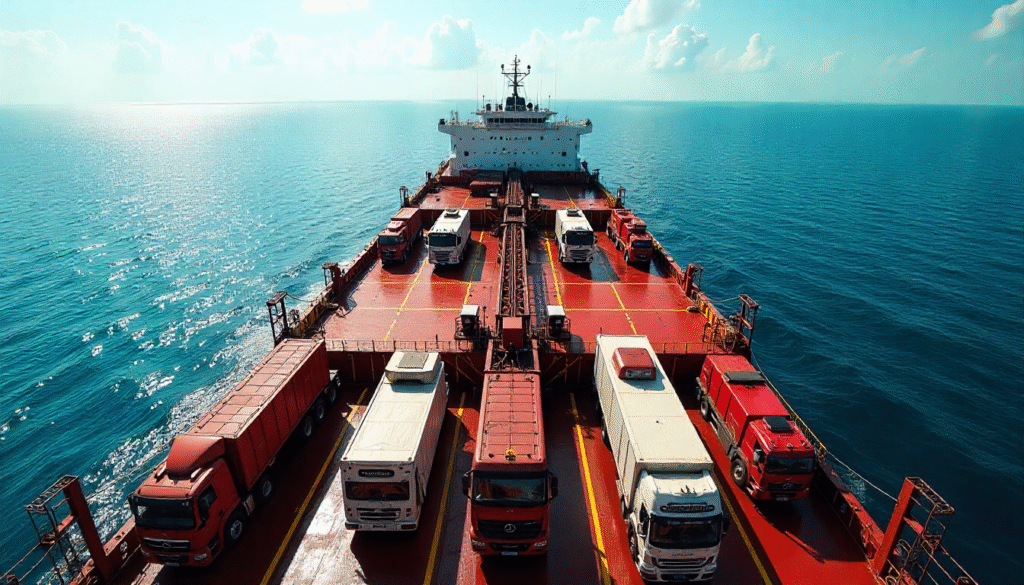RORO Ship from China to Japan: Expert Guide 2025
By Guanwutong / November 4, 2025
Let’s start with a hard truth: shipping vehicles or heavy machinery is nothing like shipping boxes.
The most expensive mistake I see companies make when shipping from China to Japan is treating their wheeled cargo like general cargo. They get a quote for a standard 40-foot container, they see a low price, and they think they’ve saved money.
They haven’t.
They’ve just walked into a value trap. The real costs are hidden. They get hit with astronomical lashing and securing fees at the Chinese port. Their vehicle arrives in Japan with scratches and dents from shifting during a rough transit. Or worse, their Japanese buyer is furious because they now need specialized equipment—ramps, cranes, and extra manpower—just to get the machine out of the steel box.
You didn’t just ship them a product. You shipped them a problem.
If you are moving cars, trucks, excavators, or any wheeled cargo to the highly precise Japanese market, you need a specialized solution. This guide is for you. We will break down the common failures in this lane and show you how using a RORO Ship (Roll-On/Roll-Off) is the only professional choice to protect your cargo, your budget, and your reputation.

1. The Container “Value Trap”: Why Your First Quote Is a Lie
The Problem You’re Facing
You need to ship a new electric vehicle or a medium-sized excavator from China to Japan. Your first instinct, or your forwarder’s lazy suggestion, is to book a standard container. The freight rate (e.g., $1,000 from Shanghai to Yokohama) looks fantastic. You book it.
Why This Matters (The Agitation)
The nightmare begins almost immediately.
Astronomical Lashing Fees: You cannot simply “park” a 3-ton vehicle inside a container. It must be meticulously secured (lashed) with a complex system of straps, chocks, and braces to prevent any movement. This is a highly specialized, manual-labor-intensive job that is not included in your freight quote. Suddenly, you’re paying hundreds of extra dollars per unit.
The High Risk of Damage: A container ship’s journey, even a short one to Japan, involves rolling, pitching, and swaying. If that lashing isn’t perfect—and it often isn’t—your vehicle will shift. We have seen machinery break free, smashing into the container walls, resulting in thousands of dollars in damages, repainting, and repair costs before your customer ever sees it.
The “Unloading Burden” You Give Your Customer: This is the relationship-killer. Your container arrives at your buyer’s facility in Japan. How do they get it out? They don’t have a built-in ramp. They now must hire a special tilt-bed truck, a forklift, or a mobile crane. It’s slow, it’s dangerous, and it’s expensive. You have failed the first test of being a good partner by making delivery a complex, multi-step problem.

The Solution: Use the Right Tool for the Job
The professional solution is to stop trying to fit a square peg in a round hole. A RORO Ship is a purpose-built “floating garage.”
A Roll-On/Roll-Off vessel is designed specifically for wheeled cargo. There is no “loading” in the traditional sense. The cargo is simply driven on at the port in China (like Shanghai or Tianjin) via a massive, built-in ramp, and driven off in Japan (like Yokohama or Kobe).
Damage Risk is Minimized: Vehicles are secured to the deck, side-by-side, as they would be in a massive, multi-story parking structure. Handling is minimal.
Lashing Costs are Eliminated: The drive-on/drive-off process removes the need for complex container lashing.
Zero Unloading Burden: Your Japanese customer receives the cargo exactly as they’d expect: they put a key in the ignition and drive it off the port. The experience is seamless, professional, and fast.
It is, without question, the safest, fastest, and—when all costs are considered—the most cost-effective method for vehicle shipping and car transport by sea.
2. Schedule Instability: The JIT (Just-in-Time) Killer
The Problem You’re Facing
You’ve successfully booked a RORO shipment. The carrier gives you a roro ship schedule with an ETD (Estimated Time of Departure) of November 10th and an ETA (Estimated Time of Arrival) of November 14th. Your Japanese client has scheduled their production line or construction project around this date.
On November 10th, you learn your cargo was “bumped” from the vessel. The new ETD is November 15th, and your customer’s entire project is now at a standstill.
Why This Matters (The Agitation)
This isn’t just a minor delay; it’s a critical failure. The Japanese market, more than almost any other, runs on a Just-in-Time (JIT) manufacturing and logistics philosophy. They don’t keep weeks of inventory; they rely on components arriving exactly when needed.
When your roroship is late, you have:
Halted Production Lines: Your customer’s factory may literally have to shut down, costing them tens of thousands of dollars per hour.
Incurred Penalties: Your contract likely has severe financial penalties for missing a delivery window.
Broken Trust: You have proven that your supply chain is unreliable. A Japanese buyer will not tolerate this. They will find a new supplier for their next order—one who can guarantee schedule integrity.
This happens because many forwarders are just “booking agents.” They don’t have real relationships. They just look for the cheapest slot on any available vessel. When a premium automotive manufacturer needs space, your single-machine shipment is the first to get pushed to the next sailing.
The Solution: Proactive Management & Carrier Alliances
Schedule reliability isn’t a bonus; it’s the entire product. A true logistics partner doesn’t just “book and pray.”
Deep Carrier Relationships: We don’t just use a search engine. We maintain long-term, high-volume contracts with the premier RORO carriers operating on the China-Japan trade lanes (like MOL, NYK, and other specialized operators). This gives us access to protected space and priority treatment, meaning your cargo doesn’t get bumped.
Proactive Route Analysis: We know the primary routes (e.g., Shanghai to Yokohama/Kobe) and the secondary routes (e.g., Tianjin to Osaka). If we see congestion building at one port, we proactively reroute your cargo to a faster, clearer port before it becomes a delay.
Transparent Communication: If a typhoon (a real risk in this lane) is forecast, we are on the phone with you days in advance, not hours later. We present you with options: “We can ship 2 days early to beat the storm, or hold for 3 days. Which do you prefer?” This puts you back in control.

3. The Documentation Nightmare: Why Cargo Gets Trapped at Japanese Customs
The Problem You’re Facing
Your RORO shipment successfully sails from China and arrives in Japan. You breathe a sigh of relief. Then you get the call from the port. Your cargo is on a customs hold.
Why This Matters (The Agitation)
A customs hold at a Japanese port is a black hole for your money. Japan Customs (Zeikan) is famously efficient, but they are also unbelievably strict. They do not tolerate errors.
Your cargo is held because:
VIN/Chassis Number Mismatch: The Vehicle Identification Number on the Bill of Lading has a typo and doesn’t exactly match the number on the vehicle itself.
Missing Compliance Certificates: You failed to provide the required import permits or technical compliance documents for the Japanese market.
Incorrect HS Code: Your forwarder used a generic code for “machinery” instead of the hyper-specific code for your excavator, triggering an inspection.
Now, your cargo is sitting at the port, racking up thousands of dollars in demurrage (storage) fees. Your “cost-effective” shipment is now a financial disaster. Worse, your customer is stuck in a bureaucratic nightmare trying to provide documents they don’t have, all while their project waits.
The Solution: A “Bulletproof” Documentation & Clearance Strategy
For Japan, documentation isn’t just paperwork; it’s the key to the country. An expert partner makes this process invisible.
Pre-Shipment Audit: Before your cargo ever leaves the factory, our team audits all documentation. We get photos of the VIN/chassis plates and match them, character for character, against the shipping documents.
HS Code & Compliance Verification: We have dedicated specialists who understand the Japanese tariff schedule. We ensure the correct HS code is used and that you have all necessary regulatory approvals (e.g., for emissions, safety standards) before booking.
NACCS Pre-Clearance: We partner with licensed Japanese customs brokers who use the NACCS (Nippon Automated Cargo and Port Consolidated System). This allows us to submit your documentation electronically while the vessel is still at sea. By the time your RORO ship docks, it often has “pre-cleared” status, allowing it to be driven off the vessel and out of the port on the same day.
This obsessive attention to detail is the only way to ensure a truly seamless, “roll-on, roll-off” experience.

4. Our RORO Service Solution Models: Precision for the Japanese Market
We don’t offer one-size-fits-all shipping. We provide tailored solutions built on the specialized RORO ship platform.
Model 1: Port-to-Port RORO (The Power User)
- Who it’s for: Experienced shippers with their own customs brokers in Japan.
What it is: We leverage our high-volume carrier contracts to provide you with the most reliable roro ship schedule and the best possible freight rates. We manage the port operations in China and the ocean leg, handing it off to your team in Japan.
Model 2: All-Inclusive DDP (The “Peace of Mind” Solution)
- Who it’s for: 90% of our clients. Businesses that want a single point of contact and zero hassle.
- What it is: This is our true “key-to-key” service.
We pick up the vehicle/machine from your factory in China.
We manage all export customs and port handling.
We ship via a premium, schedule-protected RORO shipment.
Our Japanese team manages all import customs, duties, and taxes (all pre-paid).
We deliver the cargo directly to your customer’s door.
One invoice. One price. Zero surprises.
Model 3: Project Cargo RORO (The Heavy & Oversized)
Who it’s for: Shippers with oversized cargo (e.g., cranes, mining trucks, factory components) that won’t fit in a container.
What it is: A fully-managed project. This includes route surveys, specialized inland transport, port-side supervision, and stowage planning on specialized RORO vessels designed for high-and-heavy cargo.
For any questions, feel free to contact GWT Shipping. Our team will provide professional, standards-compliant advice tailored to your specific needs.
Phần kết luận
RORO ships provide unmatched efficiency and reliability for transporting wheeled cargo—such as vehicles and heavy equipment—from China to Japan.
Unlike container shipping, RORO eliminates costly lashing fees, reduces cargo damage, and streamlines discharge operations at Japanese ports.
This mode supports Japan’s strict Just-in-Time logistics with superior schedule reliability and minimizes customs risks through specialized documentation, making it the optimal choice for automotive and machinery sectors.
Shippers should prioritize RORO for its overall value rather than just initial cost, choosing freight partners with strong RORO contracts for guaranteed space and schedule integrity.
Strict compliance with Japanese customs processes and utilizing real-time tracking technologies further protect shipments and foster trust with buyers, ensuring a future-proof, sustainable, and competitive supply chain.
Câu hỏi thường gặp
RORO (or ro ro ship) stands for “Roll-On/Roll-Off.” It is a type of vessel designed to carry wheeled cargo, such as cars, trucks, buses, and heavy machinery, that can be driven on and off the ship on their own wheels via a built-in ramp.
The biggest difference is handling. For a container, a car must be heavily lashed (strapped down) inside a metal box, which is costly and risks damage. For RORO, the car is simply driven onto the vessel and secured to the deck, similar to a parking garage. RORO is significantly safer, faster, and more cost-effective for vehicles.
The pure ocean transit time is very fast, typically 3 to 5 days. For example, Shanghai to Yokohama or Kobe is one of the quickest international RORO routes in the world. However, you must also factor in 1-2 days for port processing in China and 1-2 days for customs clearance and discharge in Japan.
You need a standard set of export/import documents, but with extreme precision. This includes a Commercial Invoice, Packing List, and Bill of Lading. Most importantly, all Vehicle Identification Numbers (VINs) or Chassis Numbers must match perfectly across all documents. You will also need any Japanese-required compliance certificates for your specific vehicle or machine.
No. This is a critical rule. For safety, security, and customs reasons, RORO carriers strictly prohibit the shipment of any personal effects, spare parts, or other cargo inside a vehicle. The car must be empty, with only the standard factory-issued items (like a spare tire).
Unlike containers (which are a flat rate), RORO shipment costs are typically calculated based on the Cubic Meter (CBM) of the cargo. The rate is determined by the vehicle’s total volume (Length x Width x Height). This is why it is highly efficient for small cars but can also be adapted for large, high-and-heavy machinery.
The primary RORO-capable ports in China for this route are Shanghai, Tianjin, and Guangzhou. In Japan, the main receiving ports with large RORO terminals are Yokohama (near Tokyo), Kobe, Osaka, and Nagoya.
Stop Risking Your Cargo. Start Shipping Like a Professional.

